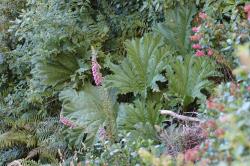- Taxon
- Weed
- Gallery
Giant, clump-forming, gynomonoecious, summergreen herb, with short, stout, horizontal rhizomes. Winter resting buds massive, to c. 25 cm long; scales pinnatisect with pinkish laciniate lobes extending to the broad green midrib. Lvs to c. 2.5 m high, rhubarb-like. Petiole to 100 × 2.5–4.5 cm, studded with conic, short, often reddish, prickles. Lamina to c. 80 × 100 cm, suborbicular, palmately 5–7-lobed to nearly ⅓ radius, somewhat rugose and scabrid above; veins sparingly hairy beneath, prominently raised, the main veins with soft prickles. Infl. paniculate, to 1 m long at fruiting; main axis 3–4.5 cm diam.; infl. branches 4–7 cm × 5–7 mm in central part of panicle. Fls dense, sessile, apetalous; ♀ c. 1 mm long. Sepals minute. Styles slightly < ovary. Drupes 1.5–2 mm long, subglobose or broad-oblong, orange. Seed 1–1.3 mm diam., acutely angled.
[From: Webb et al. (1988) Flora of New Zealand. Volume 4.]
Flowering: Oct.–Nov.




